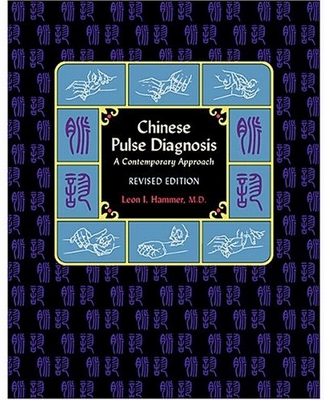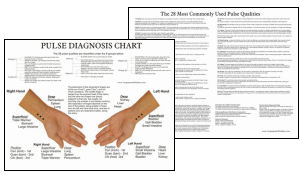Acupuncture and TCM Books
Chinese Pulse Diagnosis: A Contemporary Approach
by Leon I. Hammer
Pulse diagnosis, one of the jewels of traditional Chinese medicine, is a profoundly subtle instrument for the early diagnosis and prevention of disease. Yet far too often, in the haste of modern education and practice, it has become a neglected art. Chinese Pulse Diagnosis: A Contemporary Approach offers a clear and practical path toward a much deeper understanding of this traditional diagnostic method, while recasting its interpretation in the context of our own times.
The book is organized in seventeen chapters, which are presented in an advancing hierarchy of complexity. The early chapters consider such general issues as terminology, classification of pulse qualities, historical comparisons of positions and depths, the effects of age and gender, and a methodology for taking the pulse. The middle chapters provide an in-depth look at each of the individual pulse qualities, identified by felt sensation based on such characteristics as rate and rhythm, stability, volume, depth, size, and shape. The types of pathology associated with each of the qualities are also discussed.
Later chapters examine the significance of the qualities when found across the entire pulse, or large segments of the pulse (left or right side, across the burners), and at different depths. The relationship of the various pulse qualities to psychology and prognosis are addressed in separate chapters. A final summary chapter on interpretation, supported with case histories, draws everything together to show how this information can be formulated into a rational diagnosis.
Key information in the book is organized and richly illustrated in over one hundred tables and graphic drawings. Individual chapter tables of contents and extensive indexes provide convenient access to every aspect of this important subject.
Pulse diagnosis, one of the jewels of traditional Chinese medicine, is a profoundly subtle instrument for the early diagnosis and prevention of disease. Yet far too often, in the haste of modern education and practice, it has become a neglected art. Chinese Pulse Diagnosis: Revised Edition offers a clear and practical path toward a much deeper understanding of this traditional diagnostic method, while recasting its interpretation in the context of our own times.
The book is organized in seventeen chapters, which are presented in an advancing hierarchy of complexity. The early chapters consider such general issues as terminology, classification of pulse qualities, historical comparisons of positions and depths, the effects of age and gender, and a methodology for taking the pulse. The middle chapters provide an in-depth look at each of the individual pulse qualities, identified by felt sensation based on such characteristics as rate and rhythm, stability, volume, depth, size, and shape. The types of pathology associated with each of the qualities are also discussed.
Later chapters examine the significance of the qualities when found across the entire pulse, or large segments of the pulse (left or right side, across the burners), and at different depths. The relationship of the various pulse qualities to psychology and prognosis are addressed in separate chapters. A final summary chapter on interpretation, supported with case histories, draws everything together to show how this information can be formulated into a rational diagnosis.
Key information in the book is organized and richly illustrated in over one hundred tables and graphic drawings. Individual chapter tables of contents and extensive indexes provide convenient access to every aspect of this important subject.
REVIEWS
"Dr. Hammer has spent the last 28 years studying, demystifying, and teaching pulse diagnosis. What makes his work and this book so unique is the fact that he has taken the time to truly reveal and explain the subtleties found within the pulse. His work is based upon the lineage of Dr. John H.F. Shen and the apprenticeship that ensured. Dr. Hammer brought to this relationship the mind and spirit of a skeptical researcher, demanding that sensation, meaning, and interpretation of every pulse be both proven and repeatable.
Dr. Hammer has taken pulse diagnosis out from underneath the weight of historical antiquity and brought it into the 21st century; never before has any book on pulse diagnosis attempted such a feat. This book is certain to have a major impact on the evolution of Oriental medicine and how pulse diagnosis is practised in the future.
With over 800 pages, this book was a massive undertaking and an incredible gift to all of us who practise Oriental medicine. The only thing I can say is thank you Dr. Hammer, your work has not only saved one of our most exquisite art forms from neglect, but you have catapulted it into the future. We are indebted to you."
—Robbee Fian, The Journal of Chinese Medicine
"[An] incredible compendium . . . This book is so detailed that one may have an easier time developing an understanding of these pulses than one can get from reading such books as the available translations of Li Shi Zhen's book on the pulses . . . The descriptions of pulses given in this book include many that are applicable not only to traditional Chinese medical patterns, but also to diseases defined by biomedicine, and to a view which encompasses both."
—The Meridian Times
CONTENTS
Preliminary Reflections
Pulse Positions Through History
Basic Axioms and Other Considerations
Taking the Pulse: Methodology
Classification and Nomenclature of Pulse Qualities
Rhythm and Stability
Rate
Volume
Depth
Size: Width and Length
Shape
Individual Positions
The Three Depths and Common Qualities Found Uniformly over the Entire Pulse
Uniform Qualities in Other Large Segments of the Pulse
Qualities as Signs of Psychological Disharmony
Prognosis and Prevention
Interpretation (Appendix: Case Illustrations)
Epilogue
Endnotes
Appendix 1 Pulse Qualities: Sensation and Interpretation
Appendix 2 Glossary
Appendix 3 Bibliography
Pulse Index
General Index
Pulse Diagnosis Chart
This 8.5" X 11" double sided laminated chart shows the patients hands from the doctors perspective, making learning pulse diagnosis much easier. The chart contains list the pulse location on both right and left hand with Chinese name.
Placement of the doctors fingers for reading the pulse.
A brief description of the pulse charateristics on the front with a detailed description of the 28 pulse characteristics on the back of the chart.
Influences that affect the pulse such as seasonal changes.
 Chinese Pulse Diagnosis: A Contemporary Approach
Chinese Pulse Diagnosis: A Contemporary Approach 